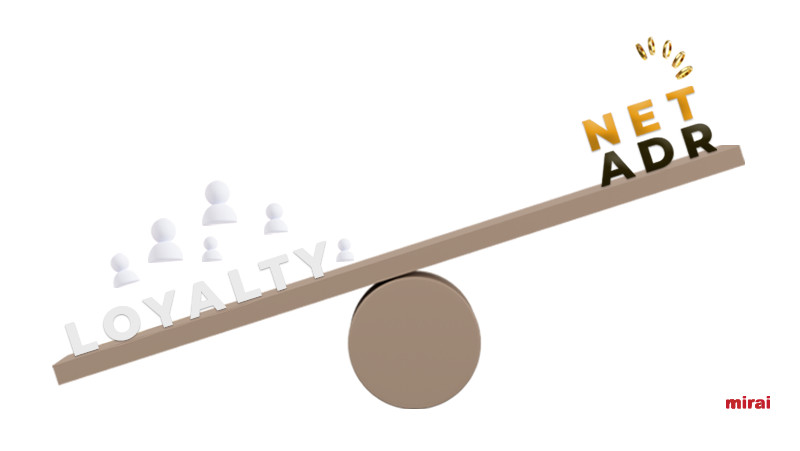Is it possible to increase your ADR by reducing your rates? Certainly not.
NB: This is an article from mirai, one of our Expert Partners
Then, why would you expect your discount-based loyalty program to increase your ADR? It’s counter intuitive and mathematically impossible. However, it’s somehow accepted by the hotel industry that loyalty increases your ADR. How would that be possible? Can we reconcile both statements?
Subscribe to our weekly newsletter and stay up to date
A clarification to start. This post is about loyalty programs based on rewards (typically discounts) received on every booking without any need to wait for a certain condition such as minimum spend or time period.
Back to our challenge. According to some studies, loyal customers (members from now on) increase your overall ADR because they book higher category room types. Even that being a fact (and we’ll see it later), the positive impact in ADR hardly reaches 1%, very far from outweighing the associated discounts in these programs (from 5% to 10%).
It’s not the different room types what explains the higher ADR. It is the stay date that makes the difference. Members repeat more often than non-members and concentrate 10% their stays the high season, pushing their overall ADR high compared to non-members. But it’s not loyalty that drives that higher ADR but the underlying seasonality. After removing it from the analysis, the conclusion is different.
Think about it this way. If you manage to fill 100% of your hotel exclusively with members that enjoy a discount, will your ADR be higher? Certainly not.
You may like it or not, but loyalty programs do decrease your ADR
Once we compare same stay dates by members and non-members, we are back comparing apples with apples. We are ready to analyze how the different variables impact your ADR in both directions. We deep dived in our own data and got the following conclusions.
Variables that have a positive impact on the ADR:
- Room type mix. As stated above, on average, members book 4.34% of the times higher category rooms than non-members, increasing 1.06% the overall ADR. We should point out that this ADR increase only happens when occupancy is not 100% and you are selling a superior room instead of a standard one. However, if a hotel reaches 100% occupancy, that same superior room sold with a discount actually decreases your ADR.
- Meal plan mix. Regardless of whether you consider meal plans as F&B (food and beverages) or a room revenue, it’s revenue nonetheless. On average, members book higher meal plans (breakfast, half board, full board or all inclusive) 6.50% more times than non-members, increasing 0.54% the overall ADR.
- Occupancy. On average, members book rooms to fit more people 7.20% more times than non-members. The impact on the overall ADR is another increase of 0.10%.
Variables that negatively impact the ADR:
- Member’s discount: Hotels typically offer a 5% to 10% discount to their members. ADR is consequently impacted by this discount and decreased in the same proportion compared to bookings by non-members.
- Booking window: Members book, on average, 13.01% more days in advance than non-members. This higher booking window means a lower 1.01% ADR.
- Length of stay: Members book, on average, 10.15% longer stays than non-members decreasing the overall ADR in 1.08%.
Putting all variables together to see the lower ADR on members’ bookings
If we combine all variables in a simple model, this is how they play out. For this example, we set a 5% discount for members. Adding up the impact of all variables, the net result is down 5.39%.





